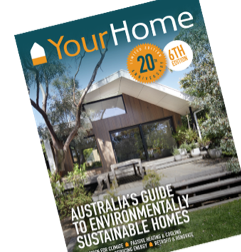Search
-
Key points
- Shading your home, particularly windows and other forms of glazing, can have a significant impact on summer comfort and energy costs.
- Appropriate shading designs and structures can help to block unwanted sun in summer while still allowing solar access in winter.
-
This passive house, BAL40 home in the Blue Mountains was built to allow the owners and their family to coexist with each other and the natural environment.
-
Key points
- Zero energy homes have an energy-efficient thermal shell and appliances, and when combined with renewable energy systems, over a year their total energy production minus their total energy use equals zero.
-
Key points
- Embodied energy is a calculation of all the energy that is used to produce a material or product, including mining, manufacture and transport.
- To achieve a home that is truly low energy, it is important to consider embodied energy when choosing materials and construction systems.
-
Key points
- If you are buying an existing home, knowing what to look for can help to ensure your home will be comfortable, cost effective to run and sustainable.
- Different features will be important in different climates. Find out your climate zone, and do some preliminary research to understand how to identify a home that suits your climate.
-
Case studies in this section are specific to Australian Climate Zones 5, 6.
-
Key points
- Renovations and additions can improve the energy and water efficiency of your home, at the same time as improving liveability and comfort.
- Do your homework to find out how your home can be most cost-effectively improved. Expert assessment and advice can help you to get the best design.
-
Key points
- Your construction system is the combination of materials used to build the roof, walls and floor of your home.
- Different construction systems suit different climates and designs, and will also have varying levels of durability, maintenance and cost.
-
Key points
- A good home design considers all aspects of the site and building – orientation, site features, thermal performance, floor plan, materials, finishes, technologies, appliances, and landscape.
-
Key points
- In the connected home, ‘smart’ or ‘connected’ home devices can be controlled automatically and remotely through your home internet or smart phone. This can save energy and money, help to reduce impacts on the electricity grid and make life easier.
-
Key points
- Insulation is a material that slows or prevents the flow of heat.
- Insulation is a key part of any passive designed home, helping to keep heat inside the home in winter and outside the home in summer.
-
Key points
- Concrete slab floors suit many home designs and, when combined with appropriate passive design, can provide thermal comfort and reduce energy use.
-
This page describes the purpose, benefits and impact of Your Home, including Design For Place. Use this information to share Your Home with your audiences.
-
A home situated on a narrow west facing block demonstrates what is possible with modern construction techniques and a collaborative interdisciplinary team.
-
Key points
- When choosing a general location, think about your lifestyle and long-term needs. Consider local climate, availability of services, transport, neighbourhood character, noise, and planning controls.
-
Six new townhouses using double glazing and solar photovoltaic (PV) systems
-
Abatement
Activity that leads to a reduction in the level of greenhouse gas emissions.
Abutment
A structure built to support the lateral pressure of an arch or span, for example at the ends of a bridge.
AccuRate


